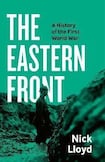
The first World War started with the assassination 110 years ago of Archduke Franz Ferdinand in Sarajevo, yet the Eastern Front is little known or understood in the West.
For understandable reasons, English-language books on the war have concentrated on the Western Front and to a lesser extent on the war in Turkey and the Middle East, where the British empire and the United States fought. Nick Lloyd’s The Eastern Front is the first English single-volume book about that front since Norman Stone’s in 1975.
This is a companion book to Lloyd’s The Western Front which was published in 2021. The Eastern Front is more than 600 pages long, which befits a front line that stretched from the Gulf of Finland to the Adriatic Sea. The book is necessarily long. There is no short way of telling such a complicated story.
The Eastern Front was a war of movement in comparison with the Western Front where the lines remained static for 3½ years. The battles were colossal and so were the casualties, 2½ million Russians and a million from the Habsburg empire among them.
READ MORE
The three main protagonists, Germany, the Austro-Hungarian empire and Russian empire, were defeated.
The Russian empire, as has been exhaustively chronicled elsewhere, withdrew from the war to preserve the nascent Bolshevik revolution. At the Treaty of Brest-Litovsk in March 1918 the that empire lost 40 per cent of its population including its holdings in Poland. The treaty lasted just six months before Germany was defeated on the Western Front. The multi-ethnic Austro-Hungarian empire was worn out, sued for peace and was dismembered after the war.
Italy was supposed to have been one of the Central Powers but entered the war as one of the Allies in 1915 in pursuit of ethnic-Italian territories held by the Austro-Hungarian empire in the mountainous northeast. There are many villains in Lloyd’s book. One of the most pronounced is the Italian chief-of-staff, Luigi Cadorna, a brutal martinet who sent his men time and again over the Izonso river, the front line in northern Italy between the Italian and Austo-Hungarian forces, the site of no fewer than 12 battles in the war.
The last one, the Battle of Caporetto in October and November 1917, ended with the Italians fleeing the battlefield, leading to his final dismissal. “I don’t care if others bring me down, I know what I’m worth,” he said afterwards. Italy lost 500,000 men in the first World War and got nothing like the territories it had anticipated despite being on the winning side. Benito Mussolini would quickly find himself in power.
The collapse of the Russian empire would be the most consequential event of the Eastern Front. It was Tsar Nicholas II’s decision in August 1914 to mobilise that turned a regional conflict between Serbia and the Austro-Hungarian empire into a global war. The story of the Russian Revolution has been told in countless books.
In Lloyd’s case, he demonstrates how events on the battlefield were pivotal in the overthrow of the Tsar and the provisional government that followed made the fatal mistake of agreeing to fight on. Provisional government leader Alexander Kerensky’s plea for the Russian empire’s soldiers to defend the revolution had initial success, but faced with a shortage of supplies on the battlefield and chaos at home the soldiers gave up and fled with the German and Austro-Hungarian soldiers in pursuit.
Vladimir Lenin did not make the same mistake and sued for peace immediately after the Bolsheviks came to power in the October Revolution. Lenin’s emissary to the Brest-Litovsk talks, Leon Trotsky, initially refused to negotiate with the Germans and declared a policy of “not war, not peace”, but the Germans were never going to stand for his obfuscation. They reopened hostilities and were within 150 miles of the capital Petrograd.
Faced with the choice between losing much of his country or losing his revolution, Lenin chose the former option and sued unconditionally for peace. Fortunately for him and his Bolshevik comrades and unfortunately for everybody else, it was the right choice.
It was out of the chaos of the first World War that the first Ukrainian state was declared in January 1918. It was short-lived and eventually the country became incorporated into the Soviet Union, but it would provide a critical template for the country that would eventually become independent in 1991. In his preface, Lloyd writes that “the weight of history still hangs over these lands”, but his treatment of Ukraine in the book is surprisingly perfunctory and does not tell us much about how the events of the first World War have directly affected the current war.
That caveat aside, this is an authoritative book written by one of the best military historians around. His third and last volume, about the Middle East and Turkey campaigns, will be eagerly awaited by those who have read his first two volumes.
- Ronan McGreevy is an Irish Times journalist, the author of Wherever the Firing Line Extends: Ireland and the Western Front (The History Press) and a tour guide to the Western Front with GTI Travel.














